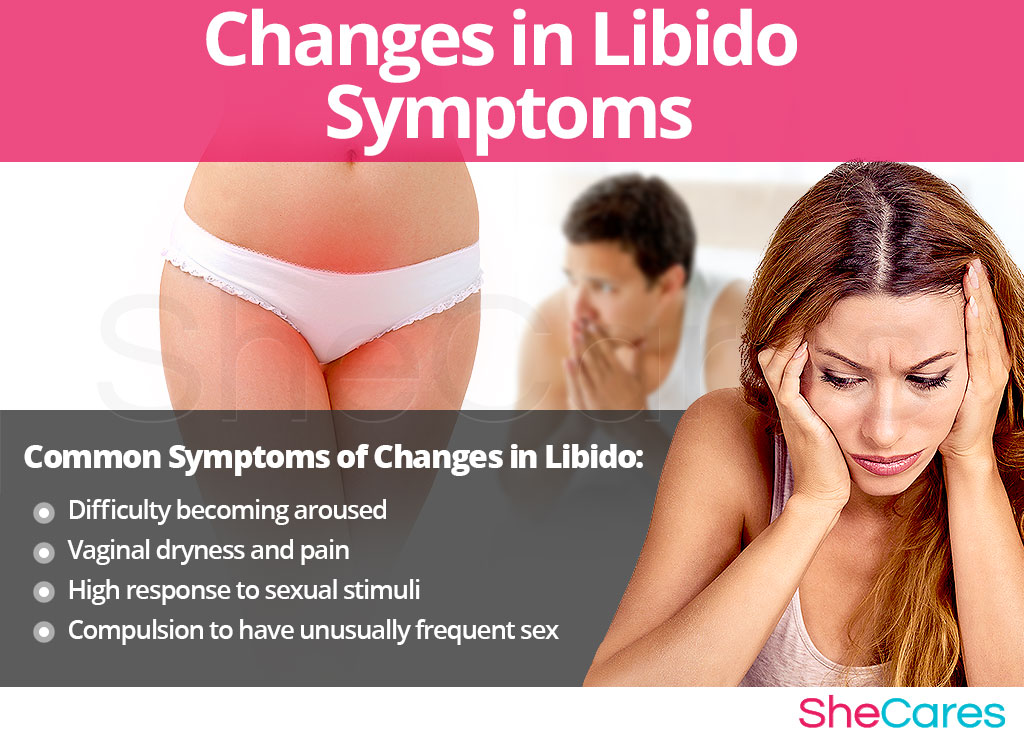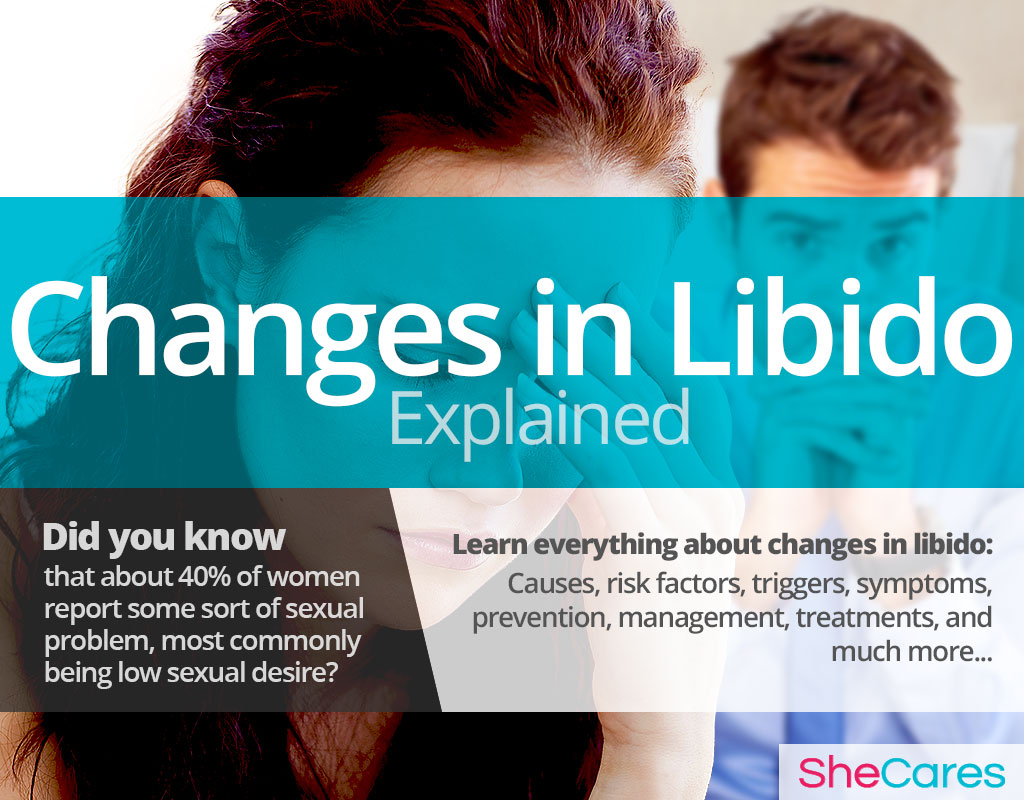About
Quick Facts about Changes in Libido
- The female sex drive is multifactorial; this means that it is influenced by both physical and emotional factors
- A 2010 study found that many young women experience guilt and distress over their sex lives.
- About 40% of women reported some sort of sexual problem, most commonly low sexual desire.
- Only 12% report feeling distressed about experiencing a sexual problem.
- Emotions are typically the cause of a decreased sex drive in younger women; the aging process itself usually causes changes in libido in women over the age of 45.
Libido is the conscious or unconscious sex drive in a person. It describes the strength of their sexual desires and interest in sex. Understanding the definition of libido is important for all women who think they may be experiencing an increased or decreased sexual desire due to fluctuating hormone levels.
The definition of libido involves clarifying the two main influences on a woman's sex drive. Firstly, a definition of libido can relate to the psychological sex drive and, secondly, to the physiological libido. The psychological definition of libido relates to a woman's conscious desire for sex, whereas the physiological relates to her bodily responses to sexual advances.
Identifying Changes in Libido
Libido varies from person to person and there is no normal level that one should strive for. It is important to be aware of what is typical for one's self and talk to a healthcare professional when experiencing dramatic shifts from that norm.
In order to understand the processes behind a fluctuating libido, continue on to the next section to read about the hormonal and non-hormonal causes.

Causes
Changes in libido have a strong correlation to hormonal changes; when hormones aren't properly balanced in the body, alterations to one's sex drive can occur. Women are especially vulnerable to these changes as they are closely related to the significant reproductive phases that occur throughout their lives.
There are additional factors that may cause libido fluctuations. These changes may also be symptomatic of another more serious condition. Continue reading to learn about the causes of changes in libido.
Hormonal Causes of Changes in Libido
Libido is strongly influenced by the changes in estrogen and progesterone levels during puberty, pregnancy, post-partum, and menopause. There are specific hormonal causes that are related to libido fluctuations depending on the stage of a woman's reproductive life in which they appear. These specific hormonal causes, combined with other factors, can influence a woman's individual experience, as shown below:
During puberty, girls begin producing fertility hormones, mainly estrogen and progesterone, and this hormone production gradually increases. This increase comes with constant fluctuations that cause an imbalance in the hormonal system and may lead to various side effects, such as an increased sex drive.
During pregnancy, the body starts to produce the pregnancy hormone - hCG - which stimulates an increase in the production of estrogen and progesterone to sustain pregnancy. Hormone levels are changing constantly to help ensure that the body provides proper care for the unborn baby.
During post-partum, there is a sudden drop in estrogen and progesterone levels. Simultaneously, pregnancy hormone levels decrease and breastfeeding hormones increase. This process brings fluctuations that cause a significant imbalance in the endocrine system, leading to a series of normal but disrupting hormonal concerns.
During menopause, the woman's body prepares for the final stages of its reproductive period. This process will result in a gradual decrease in the production of estrogen and progesterone hormones, causing fluctuations that may result in an unbalanced hormonal state.
As far as hormonal causes are concerned, it is imperative to keep the body's hormone levels in balance to avoid dramatic fluctuations in libido. Keep reading to learn more about other causes of changes in libido.
Other Causes of Change in Libido
There are many other causes that may affect a woman's libido; they can be separated into three categories: physical, psychological, and relational causes.
While hormonal imbalance is the major underlying cause of changes in libido during a woman's life, experts also point out that mood disturbances may be caused by other, less common, underlying conditions including thyroid conditions, sleep disorders, and as a side effect of certain types of medication.
Keep reading to learn what these risk factors and triggers are that have such a profound effect on a woman's experience of symptoms.

Risk Factors and Triggers
Risk Factors for Changes in Libido
Throughout a woman's life, there are particular times when she will have a greater chance of experiencing changes in libido. These times include puberty, pregnancy, post-partum, and menopause due to the significant hormonal changes that occur.
Additionally, there are a number of health factors that may influence a woman's hormone levels and increase the likelihood of libido fluctuations.
Keep reading to find out more about the triggers of libido changes.
Triggers of Changes in Libido
In addition to long-term risk factors, changes in libido can also be triggered by behavioral practices and various medications. Avoiding the following habits as much as possible may be helpful in the prevention of fluctuations in libido. These include emotional or physical stress and certain medications, as well as other external triggers.
Continue reading to learn more about the signs and symptoms of changes in libido.

Signs and Symptoms
There are emotional and physical symptoms of libido changes. These symptoms differ according to whether the change in libido is an increase or a decrease from what is typical of the woman at most points in her life.
In addition to the general symptoms, there are also medical signs that may be analyzed by a doctor to confirm diagnosis and recommend proper treatment. Keep reading to learn more about the symptoms and medical signs related to libido changes.
Common Symptoms of Libido Changes
It's difficult to measure what is a normal level of libido and what's low or high. If one partner desires sex more often than the other, it doesn't mean that either is outside of the normal levels, although these differences may cause distress. It is pivotal to see a doctor if one experiences a dramatic shift in libido to eliminate the presence of a more serious condition. Also, if one's sex drive in interfering with daily life or is seriously affecting one's personal relationships, a doctor should be contacted.
The symptoms of a change in libido aren't always physical, but they are more likely to correlate with physiological or emotional factors including vaginal dryness, changes in sexual desire and frustration.
Emotional symptoms of loss of libido:
- Lack of sexual desire
- Difficulty becoming aroused
- Frustration
Emotional symptoms of high libido:
- Abundance of sexual desire
- Compulsion to have unusually frequent sex
Physical symptoms of loss of libido:
- Vaginal dryness and pain
- Thinning of vaginal walls
- Painful intercourse
- Low response to sexual stimuli
Physical symptoms of high libido:
- High response to sexual stimuli
What other symptoms might occur with changes in libido?
In addition to these general symptoms, changes in libido may be accompanied by other symptoms that vary depending on the underlying cause or the specific stage which the woman is going through. These symptoms may be psychological (cognitive) or physical.
Diagnosis
To identify and diagnose any changes in libido, a doctor will typically review the patient's medical history and complete a brief physical examination, including a pelvic exam. Then, the doctor may order additional tests or refer the patient to a specialist, if necessary.
After the initial assessment, a doctor will provide a diagnosis and treatment options. It is important to learn about the management, prevention, and treatment of libido changes. Keep reading to find out more.

Prevention and Management
Preventing Changes in Libido
While there is no single way to completely prevent changes in libido, just as there is no way to avoid natural hormonal processes, there are a few steps that a woman can take to continually have a healthy libido.
Lifestyle changes for prevention are extremely important, especially with regard to diet, exercise, and healthy habits. Moreover, a woman may seek ways to complement these lifestyle approaches with the use of supplements that help enhance the endocrine system and, therefore, help to prevent or ease symptoms of hormonal imbalance, including changes in libido.
Managing Changes in Libido
There are steps that one can take when experiencing changes in libido to assist in promoting intimacy. These general tips include making time for your partner and openly communicating.

Treatments
Changes in libido, a common consequence of hormonal imbalance, can be frustrating for any woman who experiences them; however, sometimes these fluctuations interfere with daily life. Fortunately, it is more than possible to find an effective treatment for changes if libido.
Three Approaches to Treat Changes in Libido
Three levels of approaches can be considered for treating changes in libido. These are categorized as: (1) Lifestyle Changes, (2) Alternative Medicine, and (3) Pharmaceutical Options.
Women are encouraged to begin with the least risky approach libido fluctuations treatment, lifestyle adjustments. While medical intervention is not usually required to treat changes in sex drive, some women may wish to consider pharmaceutical options if they are unable to find relief from natural treatments. For women considering this option, it is important to understand, and carefully weigh, the risks associated with these treatments.
Lifestyle Changes for Changes in Libido
Incorporating a few lifestyle changes is the most natural, and safest, remedy for low libido. These lifestyle changes target many of the reasons women experience low libido and might be all that some women need to regain a fulfilling sex life. These changes can make a positive difference in your desire for sex.
While these changes will help alleviate libido fluctuations, they do not directly address hormonal imbalance - the most common cause of changes in libido. Therefore, further treatment may be necessary. Alternative medicine has proven to be an excellent way of treating a decreased libido related to hormonal imbalance in a safe and natural way.
Alternative Treatments for Changes in Libido
Alternative treatments are effective remedies for fluctuating libido if lifestyle changes are not enough. These medicines, which are made from herbs, and therapy are a safe and natural way to combat low libido in women.
Phytoestrogenic Herbal Supplements
These supplements, such as black cohosh, contain estrogenic components produced by plants that complement the low estrogen hormone levels in a woman's body, helping increase libido. By introducing plant-based estrogens into the body, these herbs treat the underlying hormonal imbalance behind fluctuations in libido.
These herbs, although they are effective, hinder a woman's ability to produce her own natural hormones, and can ultimately lead to an overall decrease in hormone levels.
Hormone-regulating Herbal Supplements
These supplements, including Macafem, stimulate the body's natural hormone production by nourishing the pituitary and endocrine glands, helping the whole hormonal system produce hormones more efficiently. This ultimately results in balancing not only estrogen, but other important hormones such as progesterone.
These supplements can be considered the safest and most natural way to treat the underlying hormonal imbalance behind libido changes, and can be taken throughout a woman's life, as they support the body's natural hormone production.
Additionally, sessions with a sex counselor or therapist can address many problems regarding the different aspects of one's sex life and intimacy. Therapy may include sex education, technique instruction, and recommendations for exercises or reading to complete as a couple.
A combination of approaches is usually the most effective route to take. Lifestyle changes combined with alternative medicine will most likely be the best way to alleviate the symptoms of changes in libido. However, more drastic treatment may be necessary for some women.
Pharmaceutical Options for Changes in Libido
If none of the above treatments have been effective in managing libido, some women may require a stronger remedy in the form of drugs. Because side effects may occur as a result of these treatment methods, it is recommended that pharmaceutical options, such as medications and hormone therapy, are utilized only when necessary, and under the advice and monitoring of a healthcare professional.
There are other hormone therapy treatments that are less extreme. Estrogen, in a smaller quantity, may be prescribed as a vaginal cream. This can increase blood flow to the vagina without the risks related to systemic estrogen.
These three approaches are not mutually exclusive. A woman may use different approaches at different times or any combination of them, depending on the duration and severity of symptoms. Today more and more women find that dealing with menopause symptoms is best accomplished via a combination of healthy lifestyle and alternative treatments.

Sources
- MenopauseNow. (n.d.). Loss of libido. Retrieved August 16, 2017, from https://www.menopausenow.com/loss-libido
- Low Libido. (2015). Depression, Anxiety, Stress and Poor Diet - the Top Libido Killers in Women's Sex Life. Retrieved August 16, 2017, from
http://www.lowlibido.org/depression-anxiety-stress-poor-diet-kill-libido.html - Mayo Clinic. (2015). Low sex drive in women. Retrieved August 16, 2017, from http://www.mayoclinic.org/diseases-conditions/low-sex-drive-in-women/basics/definition/con-20033229
- Virtual Medical Center. (2017). Sexuality After Childbirth. Retrieved August 16, 2017, from http://www.virtualmedicalcentre.com/healthandlifestyle/sexuality-after-childbirth/163



